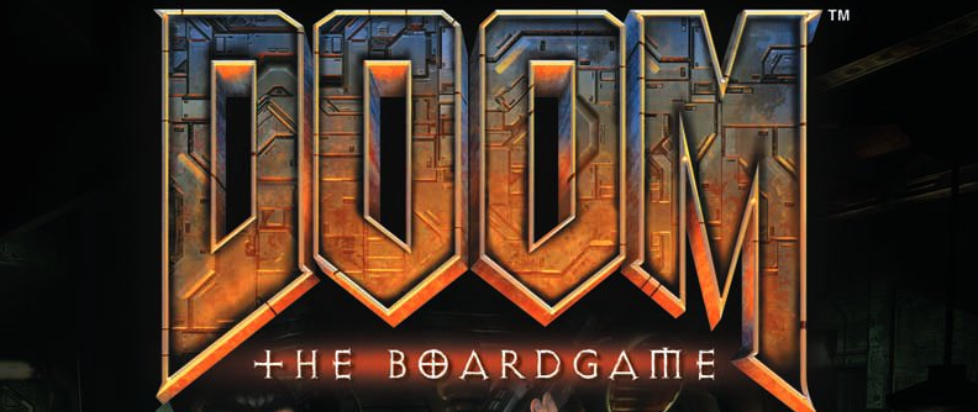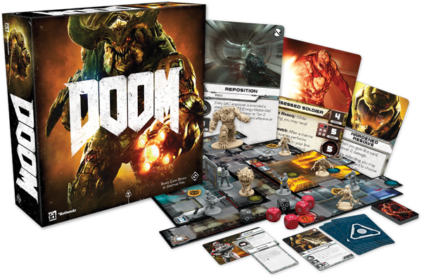
Fragged!: Translating DOOM to the Tabletop via a Somewhat Unlikely Route
I see board games in the store and they always look so cool and then I buy them and bring them home, I’m so excited to open them, and then I play them, like, twice… This column is dedicated to the love of games for those of us whose eyes may be bigger than our stomachs when it comes to playing, and the joy that we can all take from games, even if we don’t play them very often.
Dungeon crawl board games have been around almost as long as the tabletop RPGs they’re emulating. Dungeon! first appeared on the scene in 1975, just a year after Dungeons & Dragons invented the form, and HeroQuest gave us the model for the modern dungeon crawler in 1989. However, for a long time, the gold standard for dungeon crawl board games was probably Descent, first published by Fantasy Flight Games in 2005.
So, imagine my surprise when I learned that Descent did not begin life as a fantasy-themed dungeon crawler at all but rather as the first attempt to import the hit video game Doom to the tabletop. Released in 2004, Doom: The Board Game provided the basic mechanical system that Descent would revise and repurpose to create the game that was, for at least a decade, the top tier of the dungeon crawl experience.
I never played the original version of Doom: The Board Game – which, in photos, looks a lot like Space Hulk – but I picked up the 2016 re-release, which changed its title to all-caps and its aesthetics to match the 2016 video game of the same name, rather than Doom 3, which the previous board game had used as its template.

To be clear, I have also basically never played any of the Doom video games. I played the first one or two way back when they first came out, but FPS games were never really my brand and I never played Doom more than a few times. I did, however, watch the movie version from 2005, with the Rock and Judge Dredd, so I figure I probably know what I’m talking about here.
For real, though, Doom is one of those things that you’re going to understand, at least a little, simply by dint of cultural osmosis. It’s impossible to be at all active in the realms of games or horror and not at least pick up the gist, over time. So, how does DOOM: The Board Game translate a game I don’t know all that well onto the table? The answer seems to be: weirdly.
As I mentioned, DOOM runs on basically the same engine as Descent – or rather, vice versa – which means that, like Space Hulk, DOOM plays using pre-generated maps and missions and, like Descent, there’s essentially a GM.
For those who have never played the first or second edition of Descent, one player takes the role of the Overlord, who controls all of the monsters and enemies and otherwise generally tries to thwart the heroes. (In the newest edition of the game, the Overlord role is replaced with an app.) It’s similar to the asymmetric skirmishes of a game like Space Hulk, but instead of two players each controlling unmatched squads of figures, it’s each other player taking on a single adventurer and going up against one player who controls everything else.
In DOOM, the same thing happens, but the Overlord is instead called the Invader. The idea is the same, though. The Invader controls the demons, plays event cards, and generally tries to “frag” the rest of the players and achieve whatever victory conditions allow them to win the mission. Meanwhile, all of the other players (up to four) control individual UAC marines with their own abilities, goals, and collective victory conditions.

This arrangement mostly works for Descent, where the Overlord feels like a more antagonistic (hopefully) version of a standard RPG game master. In DOOM, however, the fit feels stranger, especially when combined with the pre-gen maps and missions. Because the entire map is already laid out when you start play, there’s very little sense of exploration in DOOM: The Board Game – very few chances for that FPS experience of rounding a corner to have something jump out at you unexpectedly.
Compare DOOM to, say, Resident Evil 2: The Board Game, which I covered here a few months back. Resident Evil is another attempt to translate a horror-themed video game to the tabletop – albeit, admittedly, one that skews more horror and less action than DOOM and its namesakes. Like DOOM, that game uses pre-generated maps, but it has a number of tricks up its sleeve to help it generate tension and the claustrophobic feeling of a survival horror game.
There’s none of that in DOOM. There’s not even the faint fobs Space Hulk made to its horror roots with things like “blip” tokens. Despite the box art and the demonic miniatures, DOOM is fundamentally an action game that isn’t particularly interested in horror.
Which is not to say that it doesn’t know how to do action. DOOM is not, after all, a direct clone of Descent – or, again, vice versa – and the places where it deviates, such as the deck of action cards which the marine players use on their rounds, and the way those action cards are altered by equipment they pick up, help the game not only feel dynamic, but also harken back to its video game origins.
Those same video game origins just feel like they would be more at home playing a co-op game against the board, however, as one does in Resident Evil, rather than a game against a human opponent taking on the role of Descent’s dungeon master-like Invader and crowding the board with DOOM‘s gnarly demons.





